Abstract
An outbreak of brucellosis caused by Brucella abortus biovar 2 was identified in cattle in Alberta in December 1986. This was the only clinical infection discovered since the national cattle herd was declared brucellosisfree in 1985. It was the first report of B. abortus biovar 2 in Canadian cattle. The outbreak, involving three herds containing purebred Hereford cattle, was spread by the private treaty sale of untested cattle, and was identified following investigation of an abortion. The source of infection for the outbreak was not established, but several possibilities were identified including infected herds present in the area during the mid-1970's, latent infection originating in a Saskatchewan herd during the early 1960's, American cattle imported during the early 1970's, and brucellosis-infected bison in Wood Buffalo National Park. The containment and elimination of this nidus of infection appears to have been successful, and the national cattle herd at the time of writing is free of the disease.
Full text
PDF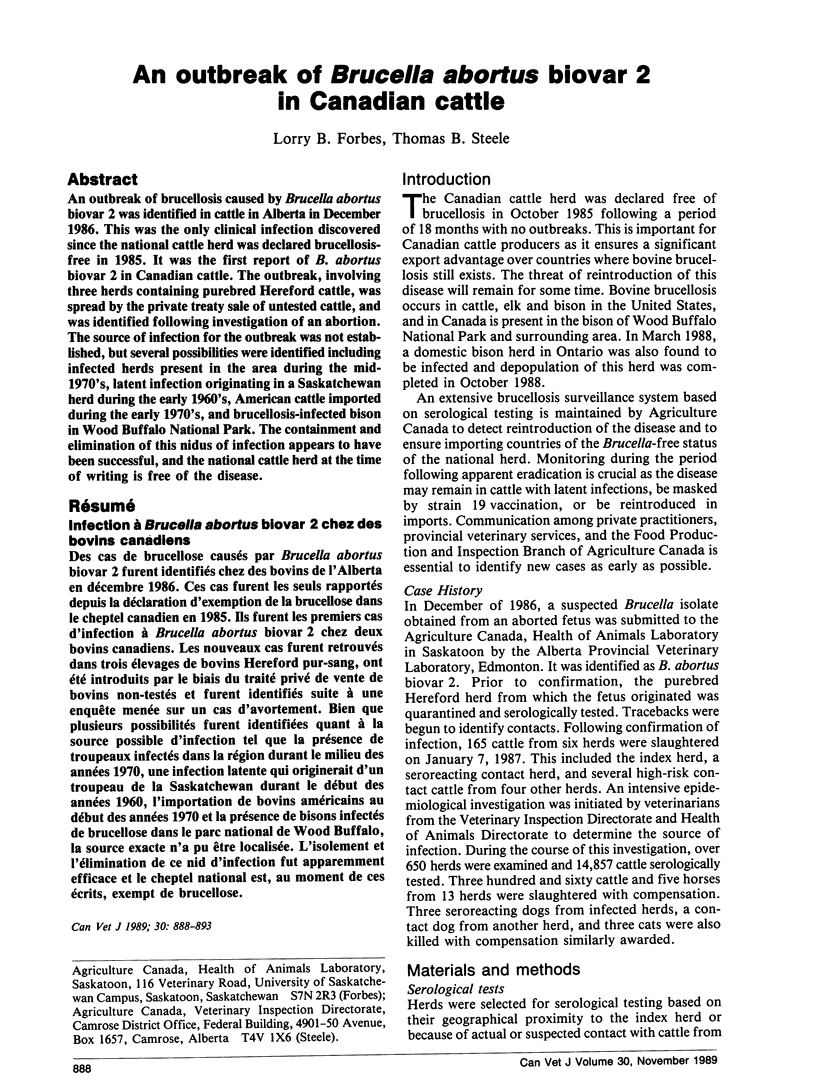
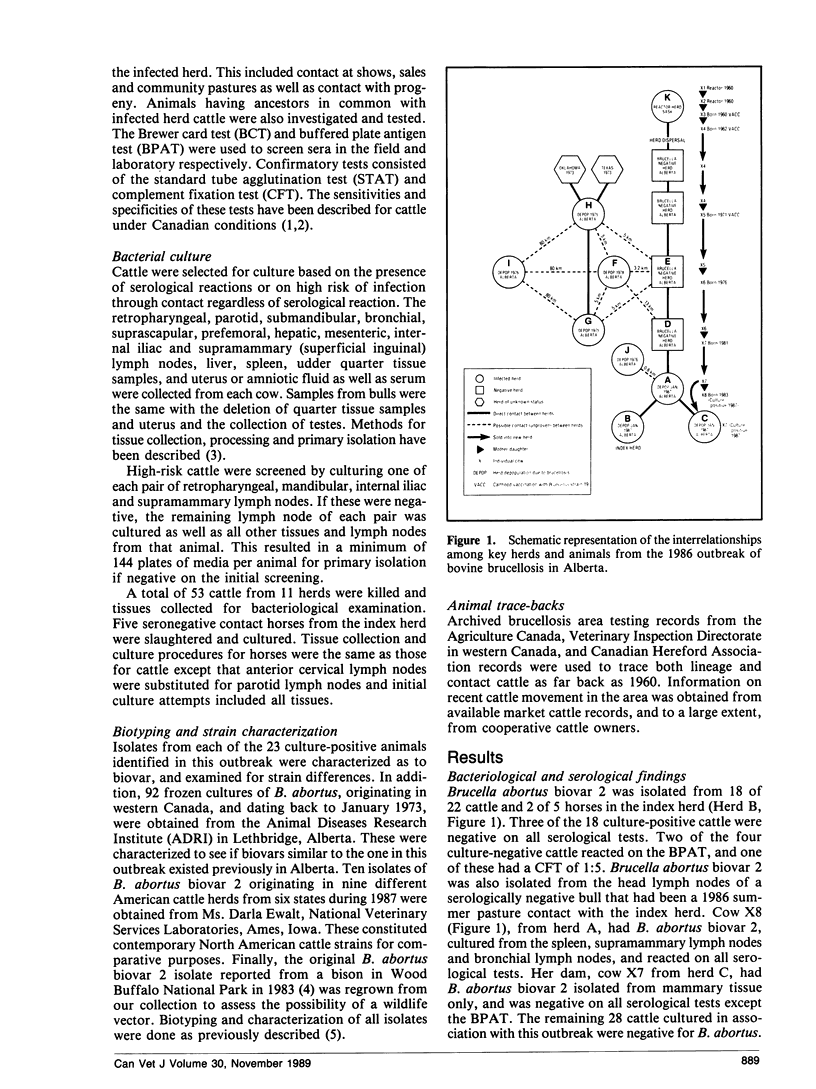
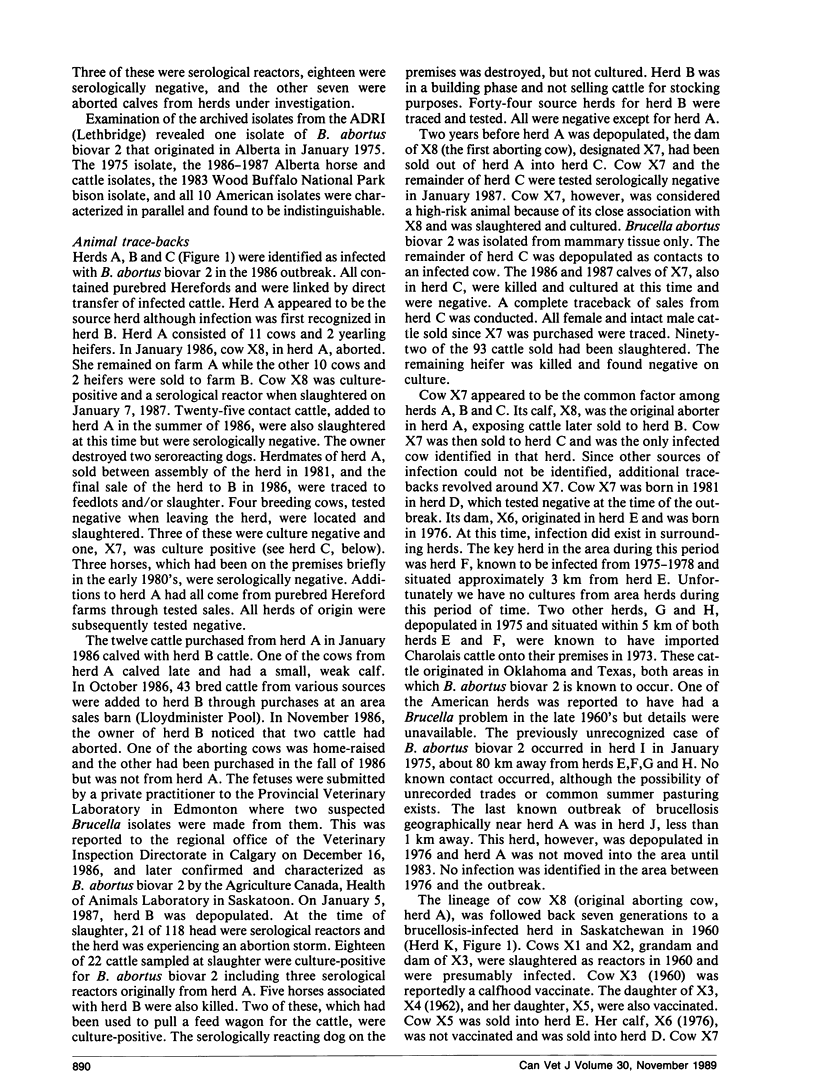
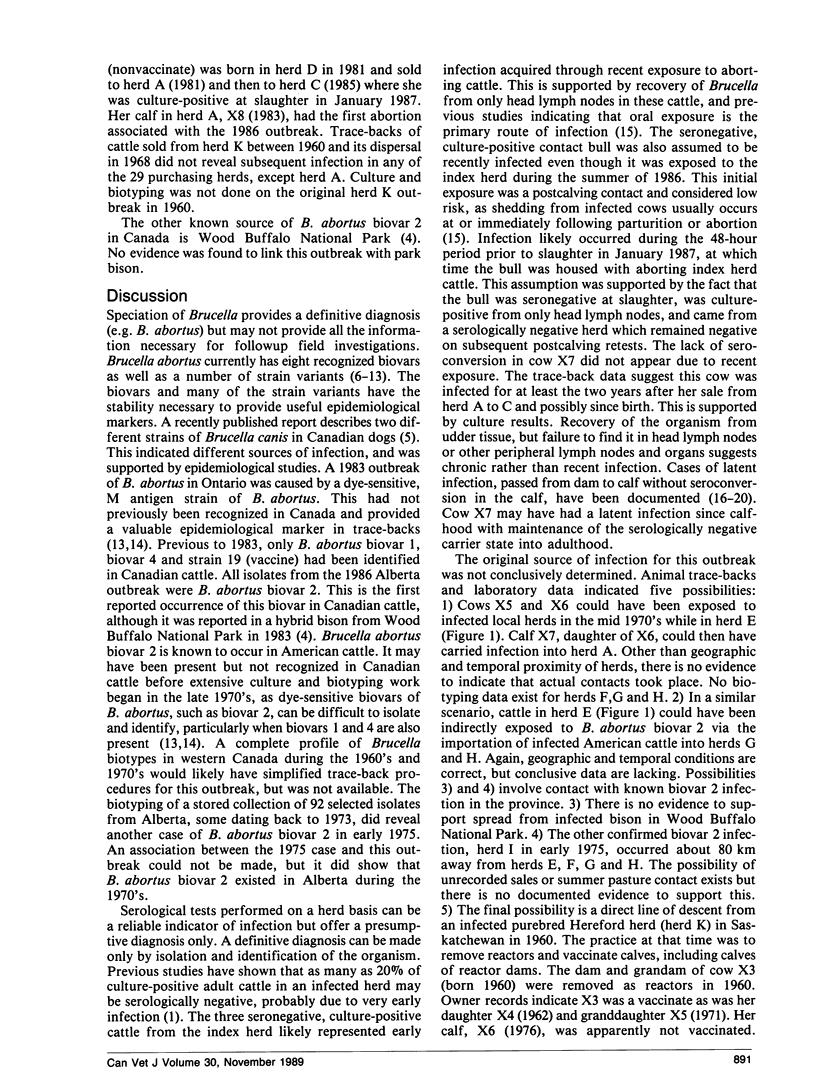
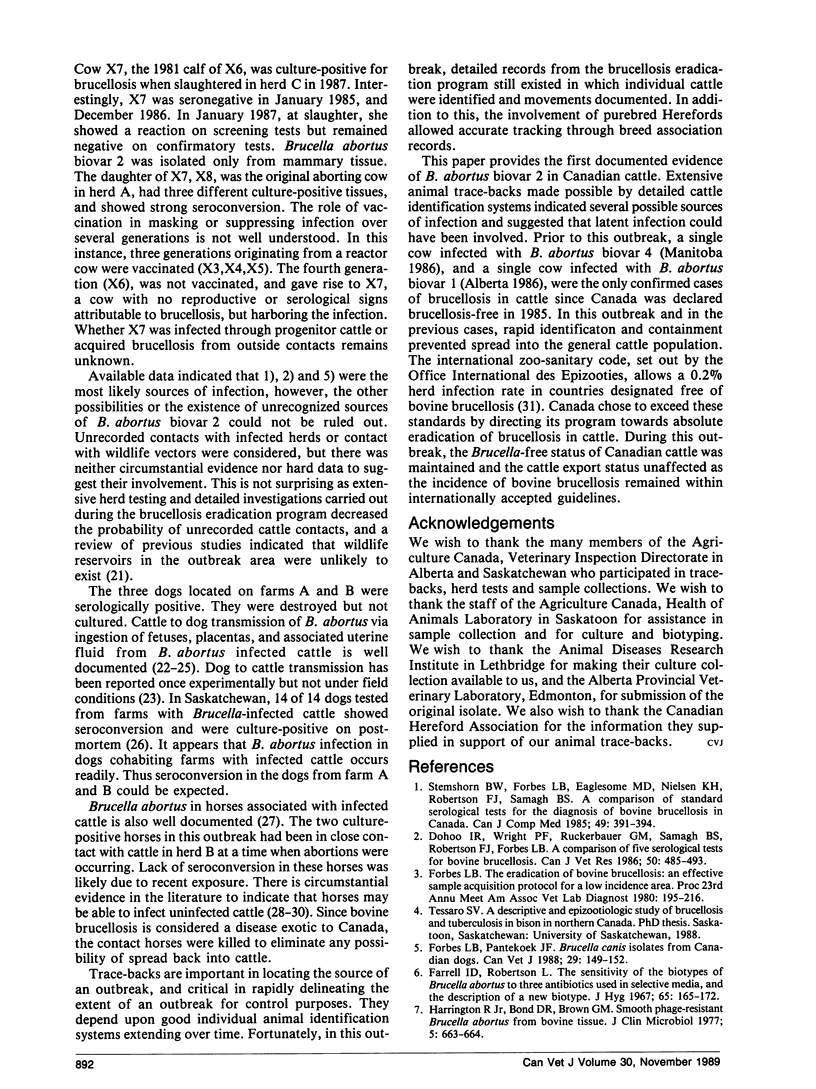
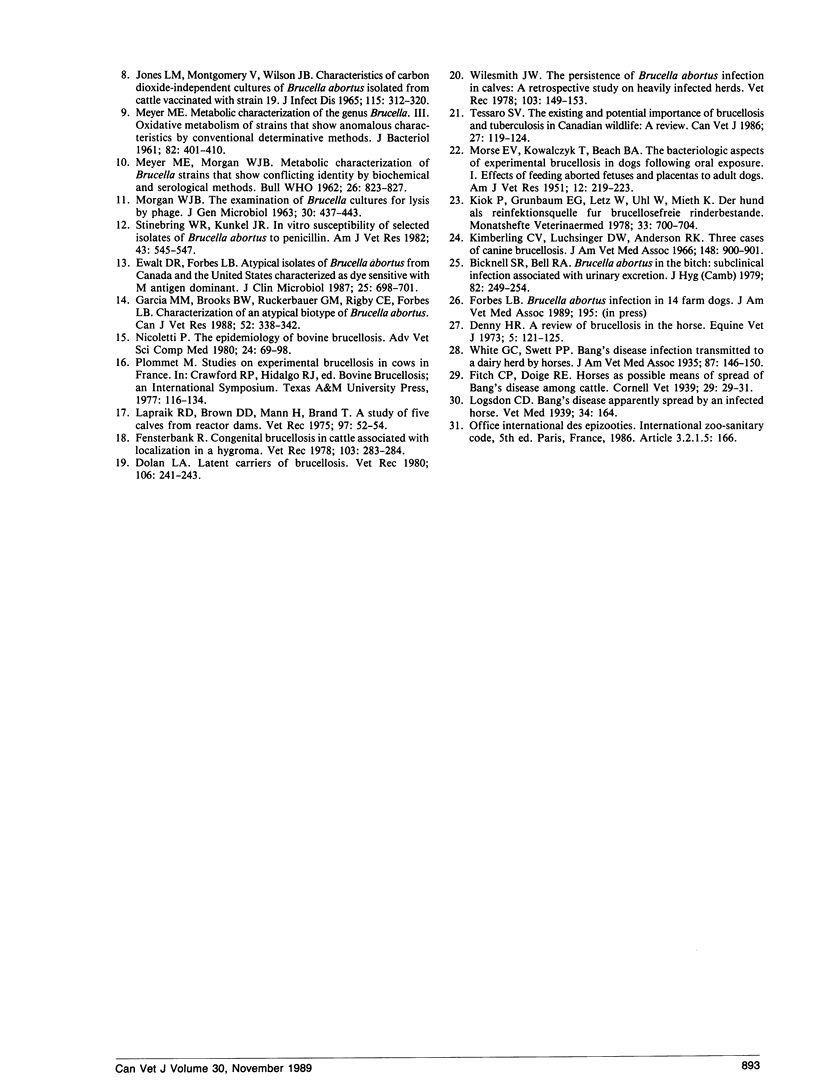
Selected References
These references are in PubMed. This may not be the complete list of references from this article.
- Bicknell S. R., Bell R. A. Brucella abortus in the bitch: subclinical infection associated with urinary excretion. J Hyg (Lond) 1979 Apr;82(2):249–254. doi: 10.1017/s0022172400025663. [DOI] [PMC free article] [PubMed] [Google Scholar]
- Denny H. R. A review of brucellosis in the horse. Equine Vet J. 1973 Jul;5(3):121–125. doi: 10.1111/j.2042-3306.1973.tb03208.x. [DOI] [PubMed] [Google Scholar]
- Dohoo I. R., Wright P. F., Ruckerbauer G. M., Samagh B. S., Robertson F. J., Forbes L. B. A comparison of five serological tests for bovine brucellosis. Can J Vet Res. 1986 Oct;50(4):485–493. [PMC free article] [PubMed] [Google Scholar]
- Dolan L. A. Latent carriers of brucellosis. Vet Rec. 1980 Mar 15;106(11):241–243. doi: 10.1136/vr.106.11.241. [DOI] [PubMed] [Google Scholar]
- Ewalt D. R., Forbes L. B. Atypical isolates of Brucella abortus from Canada and the United States characterized as dye sensitive with M antigen dominant. J Clin Microbiol. 1987 Apr;25(4):698–701. doi: 10.1128/jcm.25.4.698-701.1987. [DOI] [PMC free article] [PubMed] [Google Scholar]
- Fensterbank R. Congenital brucellosis in cattle associated with localisation in a hygroma. Vet Rec. 1978 Sep 23;103(13):283–284. doi: 10.1136/vr.103.13.283. [DOI] [PubMed] [Google Scholar]
- Forbes L. B., Pantekoek J. F. Brucella canis Isolates from Canadian Dogs. Can Vet J. 1988 Feb;29(2):149–152. [PMC free article] [PubMed] [Google Scholar]
- Garcia M. M., Brooks B. W., Ruckerbauer G. M., Rigby C. E., Forbes L. B. Characterization of an atypical biotype of Brucella abortus. Can J Vet Res. 1988 Jul;52(3):338–342. [PMC free article] [PubMed] [Google Scholar]
- Harrington R., Jr, Bond D. R., Brown G. M. Smooth phage-resistant Brucella abortus from bovine tissue. J Clin Microbiol. 1977 Jun;5(6):663–664. doi: 10.1128/jcm.5.6.663-664.1977. [DOI] [PMC free article] [PubMed] [Google Scholar]
- JONES L. M., MONTGOMERY V., WILSON J. B. CHARACTERISTICS OF CARBON DIOXIDE-INDEPENDENT CULTURES OF BRUCELLA ABORTUS ISOLATED FROM CATTLE VACCINATED WITH STRAIN 19. J Infect Dis. 1965 Jun;115:312–320. doi: 10.1093/infdis/115.3.312. [DOI] [PubMed] [Google Scholar]
- Kimberling C. V., Luchsinger D. W., Anderson R. K. Three cases of canine brucellosis. J Am Vet Med Assoc. 1966 Apr 15;148(8):900–901. [PubMed] [Google Scholar]
- Lapraik R. D., Brown D. D., Mann H., Brand T. Brucellosis: a study of five calves from reactor dams. Vet Rec. 1975 Jul 19;97(3):52–54. doi: 10.1136/vr.97.3.52. [DOI] [PubMed] [Google Scholar]
- MEYER M. E., MORGAN W. J. Metabolic characterization of Brucella strains that show conflicting identity by biochemical and serological methods. Bull World Health Organ. 1962;26:823–827. [PMC free article] [PubMed] [Google Scholar]
- MEYER M. E. Metabolic characterization of the genus Brucella. III. Oxidative metabolism of strains that show anomalous characteristics by conventional determinative methods. J Bacteriol. 1961 Sep;82:401–410. doi: 10.1128/jb.82.3.401-410.1961. [DOI] [PMC free article] [PubMed] [Google Scholar]
- MORSE E. V., KOWALCZYK T., BEACH B. A. The bacteriologic aspects of experimental brucellosis in dogs following oral exposure. I. Effects of feeding aborted fetuses and placentas to adult dogs. Am J Vet Res. 1951 Jul;12(44):219–223. [PubMed] [Google Scholar]
- Nicoletti P. The epidemiology of bovine brucellosis. Adv Vet Sci Comp Med. 1980;24:69–98. [PubMed] [Google Scholar]
- Stemshorn B. W., Forbes L. B., Eaglesome M. D., Nielsen K. H., Robertson F. J., Samagh B. S. A comparison of standard serological tests for the diagnosis of bovine brucellosis in Canada. Can J Comp Med. 1985 Oct;49(4):391–394. [PMC free article] [PubMed] [Google Scholar]
- Stinebring W. R., Kunkel J. R. In vitro susceptibility of selected isolates of Brucella abortus to penicillin. Am J Vet Res. 1982 Mar;43(3):545–547. [PubMed] [Google Scholar]
- Tessaro S. V. The existing and potential importance of brucellosis and tuberculosis in canadian wildlife: a review. Can Vet J. 1986 Mar;27(3):119–124. [PMC free article] [PubMed] [Google Scholar]
- Wilesmith J. W. The persistence of Brucella abortus infection in calves: a retrospective study of heavily infected herds. Vet Rec. 1978 Aug 19;103(8):149–153. doi: 10.1136/vr.103.8.149. [DOI] [PubMed] [Google Scholar]


